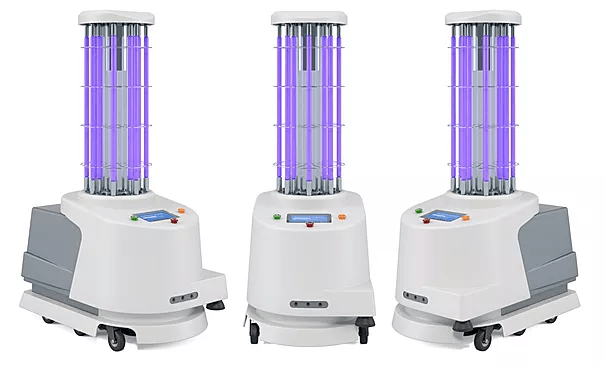Technology is front and center in the fight against Covid-19. Whether dealing with the initial supply chain ramifications, preparing for recovery, or fighting the effects of the virus itself, technology is playing a critical role.
Organizations looking to utilize this technology during the current crisis should apply similar logic to the mitigation frameworks used by major cybersecurity events companies.
This framework includes five phases: Identify, Detect, Protect, Respond, and Recover.
Identify and Detect Phase
During the Identify and Detect phase, companies need to leverage technology to map out their business environment, monitor it for issues, assess risks to their corporate assets, and develop a risk mitigation strategy for existing and future risks.
Toronto-based startup BlueDot, has developed an algorithm to predict global pandemics and their spread by using big data and machine learning to identify patterns indicating a pandemic.
In the case of Covid-19, BlueDot alerted its private-sector and government clients on December 30, 2019 about a cluster of “unusual pneumonia” cases happening around a market in Wuhan, China. They were also able to correctly identify the cities that were highly connected to Wuhan through global airline ticketing data to anticipate the spread of the virus.
Below is a snapshot of their BlueDot Explorer tool that helps identify potential pandemic patterns:

Protect and Respond Phase
During the Protect and Respond phase, known problems need to be isolated, critical assets secured, and personnel trained on how to avoid and mitigate the spread of a virus based on data insight.
In this phase, companies, governments and global citizens are leveraging technology to help them manage and remediate disasters, pandemics, disruptions and risks.
These technologies include big data tracking of the virus spread, monitoring infections leveraging artificial intelligence, surveillance technology, robotics and enabling new business models for touchless ecommerce, channels enabling different ways to transact and purchase essential goods during a pandemic.
Close Contact Tracing:
Apple and Google will be launching a comprehensive solution that includes application programming interfaces (APIs) and operating system-level technology to assist in enabling contact tracing. The idea is to quickly identify and trace individuals to contain the spread on a larger scale leveraging public and surveillance data combined with mobile tracing apps.

This is a concept that was already successfully used in Wuhan, where patients and the general population are tracing the infection patterns to prevent larger spread of the virus.
Users sign up for a “close contact detector” app by registering using their phone number, name, or scanning a QR code on their smartphones. Based on the available data the app then recommends who should self-quarantine.
Ultraviolet Light Robots
“Please leave the room, close the door, and start a disinfection,” says a voice from a UVD robot when initiating the disinfection of a hospital room. Current models can disinfect a hospital room in 20 minutes.

These robots have been used heavily in China, particularly in Wuhan according to UVD Robots Vice President of Sales, Simon Ellison.
Smart City Investments
To effectively trace the spread of viruses in densely populated areas, investments in smart technology has accelerated significantly, bolstered by the soon to be available 5G that will make truly-connected cities and homes.
This, in turn, could enable government agencies to more effectively detect and trace the spread of viruses. According to Business Insider Intelligence, smart city investments will reach $295 Billion by 2025, up from $131 Billion in 2020:

Surveillance Technologies
While drones in South Korea spray disinfectant, police in Dubai are wearing smart thermal imaging helmets to detect heightened body temperature in real time.
These helmets can record the thermal temperature of 100 suspects within 2 minutes. Originally the helmets, by Kuang-chi technology, were designed to track criminals leveraging facial recognition and reading car license plates automatically, but now have been used in several Chinese cities.
A leading AI firm, Sense Time, has deployed temperature detection software to public transportation, schools and community centers in Beijing and Shanghai to fight the spread of the virus, even claiming that they can recognize faces when wearing a mask with a “relatively high degree of accuracy.”
Drone Social Distance Monitoring
While drones are being used for delivery of goods and medical supplies to reduce the chance of virus spread, other uses include the monitoring of crowds to enforce social distancing.
Loudspeakers fitted on the drones are used to warn people about the health risks of coming too close to one another without recording individuals or violating data privacy regulation.
Since various cities in the United States are opening their gates to beaches and other non-essential services, this technology may prove beneficial in keeping the virus infection curve flat.
Privacy Concerns
Of course, this use of surveillance technologies opens up a world of data-privacy concerns, with the notion that these invasive technologies are going to be difficult to separate from our lives post-pandemic.
With the deployment of disruptive solutions and unexpected growth of the use of existing technology, security often is an afterthought. This was experienced by users of the Zoom collaboration tool followed by a wild scramble to deploy security updates to their suite of tools making them more secure.
There are already examples of cybercriminals trying to take advantage of the situation, with phishing attacks luring remote employees to click links and unknowingly provide sensitive data. Since remote work and remote secured laptops have been an afterthought for some organizations, they quickly need to accelerate their learning curve and propel previously unfunded digital transformation programs to the forefront.
There is also going to be a heavy burden on the democratic process, governments, and the enforcement of privacy regulation in ensuring that the state of in-depth surveillance to fight the virus is not an opening for bad actors and an invitation for knowingly or unknowingly violating individuals’ data privacy rights.
Recover Phase
As with anything, there is also a ton of opportunity to distinguish a company’s services by leveraging technology and to invest in people that will be using these technologies during the recovery, propelling companies back to growth mode.
In the Recover phase, companies need to identify improvements, scenario plan for recovery, and support actions with proactive and regular communications.
Deloitte created this dashboard which not only tracks the spread of the pandemic, but also visualizes economic recovery metrics such as unemployment, retail sales, transportation and industries.
New Business Models to Initiate the Recover Phase
From the usual suspects of grocery delivery companies like Instacart, Freshly, and Peapod, customers are getting more familiar with new channels to get access to product they desire during home isolation.
That is what caused a 500% surge of orders and new customer acquisitions for alcoholic beverage delivery software company, Drizly.com.
Based on the severity of this pandemic, there is a seismic shift in the short, and likely long-term preferences, behaviors and expectations of individuals as citizens, as employees, and as consumers. The graph below clearly indicates this with essential hygiene products and household staples compared to travel and vacation related items.

Some changes and opportunities for business leaders and consumers alike to monitor in the upcoming weeks and months creating opportunity to differentiate and (re)capture market share:
- Skilled workforce entering the Gig economy market after being impacted by Covid-19, enabled by technology to do remote work.
- Shift from global supply chain towards regional with production and sourcing moving closer to the consumer.
- Shutting down production and focus on delivering goods during the pandemic can shine a light on what services are truly essential versus nice to have, exposing opportunities for efficiencies.
- With less physical workforce available at production locations, companies are already heavily investing in robotics and automation – so coming out of the recession, some jobs will need to shift towards operating these.
- Based on new technology needs, workers – white collar and blue collar alike – need to invest in education while in lockdown with a focus on skills needed in a decentralized, hyper-automated and touchless economy.
- Shift towards subsidized BYOD (bring your own device) enabled by advanced authentication of devices.
- Many services can be done remotely and businesses are already embracing this in remote healthcare services, remote therapy, remote gym classes, remote touchless delivery and others.
Let me close with a quote by Ian Davis, former Managing Partner at McKinsey, who underlines the notion that long-term vision trumps short sighted measures to come out strong out of this pandemic and recession:
“For some organizations, near-term survival is the only agenda item. Others are peering through the fog of uncertainty, thinking about how to position themselves once the crisis has passed and things return to normal. The question is, ‘What will normal look like?’ While no one can say how long the crisis will last, what we find on the other side will not look like the normal of recent years.”
Disclaimer: The opinions expressed in this post are my own personal views regarding IT strategy, trends and architecture.











